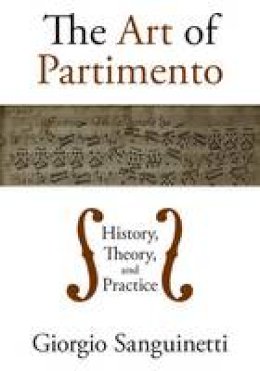
Stock image for illustration purposes only - book cover, edition or condition may vary.
The Art of Partimento: History, Theory, and Practice
Giorgio Sanguinetti
€ 129.47
FREE Delivery in Ireland
Description for The Art of Partimento: History, Theory, and Practice
Hardback. In The Art of Partimento, performer and historian Giorgio Sanguinetti provides students and scholars of composition and music theory an historical chronicle as well as a practical guide, offering them the opportunity not only to understand the life of this fascinating tradition, but to participate in it as well. Num Pages: 420 pages, Illustrations. BIC Classification: AVA. Category: (G) General (US: Trade). Dimension: 255 x 183 x 20. Weight in Grams: 800.
At the height of the Enlightenment, four conservatories in Naples stood at the center of European composition. Maestros taught their students to compose with unprecedented swiftness and elegance using the partimento, an instructional tool derived from the basso continuo that encouraged improvisation as the path to musical fluency. Although the practice vanished in the early nineteenth century, its legacy lived on in the music of the next generation. In The Art of Partimento, performer and music-historian Giorgio Sanguinetti chronicles the history of this long-forgotten Neopolitan art. Sanguinetti has painstakingly reconstructed the oral tradition that accompanied these partimento manuscripts, now scattered throughout Europe. Beginning with the origins of the partimento in the circles of Corelli, Pasquini, and Alessandro Scarlatti in Rome and tracing it through the peak of the tradition in Naples, The Art of Partimento gives a glimpse into the daily life and work of an eighteenth century composer. The Art of the Partimento is also a complete practical handbook to reviving the tradition today. Step by step, Sanguinetti guides the aspiring composer through elementary realization to more advanced exercises in diminution, imitation, and motivic coherence. Based on the teachings of the original masters, Sanguinetti challenges the reader to become a part of history, providing a variety of original partimenti in a range of genres, forms, styles, and difficulty levels along the way and allowing the student to learn the art of the partimento for themselves at their own pace. As both history and practical guide, The Art of Partimento presents a new and innovative way of thinking about music theory. Sanguinetti's unique approach unites musicology and music theory with performance, which allows for a richer and deeper understanding than any one method alone, and offers students and scholars of composition and music theory the opportunity not only to understand the life of this fascinating tradition, but to participate in it as well.
Product Details
Publisher
Oxford University Press Inc
Number of pages
416
Format
Hardback
Publication date
2012
Condition
New
Number of Pages
420
Place of Publication
New York, United States
ISBN
9780195394207
SKU
V9780195394207
Shipping Time
Usually ships in 4 to 8 working days
Ref
99-2
About Giorgio Sanguinetti
Giorgio Sanguinetti is Associate Professor of Music Theory at the University of Rome - Tor Vergata.
Reviews for The Art of Partimento: History, Theory, and Practice
Sanguinetti's book is a comprehensive and highly organized account of an exceedingly complex musical art.
David Chapman, Notes
This wonderful book explores the rules of this multifaceted compositional shorthand.
Music Teacher
Giorgio Sanguinettis The art of partimento is a very impressive accomplishment, not only for its groundbreaking effort to sketch the history of this largely uncovered repertory, but also for the very useful list of sources on the companion website and for the beautiful linearity of many of his realizations in the third part of the book. This book will benefit not only keyboardists but also advanced players of the lute and theorbo, at least those who have acquired skills in playing without tablature. Sanguinettis monograph has the potential to enrich deeply the study of harmony, counterpoint and fugue, as it enables the reader to reconstruct a unique and historically founded synthesis between practical playing and theoretical learning, using teaching material from some of the most distinguished masters of the 18th century.
Peter van Tour, Early Music
David Chapman, Notes
This wonderful book explores the rules of this multifaceted compositional shorthand.
Music Teacher
Giorgio Sanguinettis The art of partimento is a very impressive accomplishment, not only for its groundbreaking effort to sketch the history of this largely uncovered repertory, but also for the very useful list of sources on the companion website and for the beautiful linearity of many of his realizations in the third part of the book. This book will benefit not only keyboardists but also advanced players of the lute and theorbo, at least those who have acquired skills in playing without tablature. Sanguinettis monograph has the potential to enrich deeply the study of harmony, counterpoint and fugue, as it enables the reader to reconstruct a unique and historically founded synthesis between practical playing and theoretical learning, using teaching material from some of the most distinguished masters of the 18th century.
Peter van Tour, Early Music
